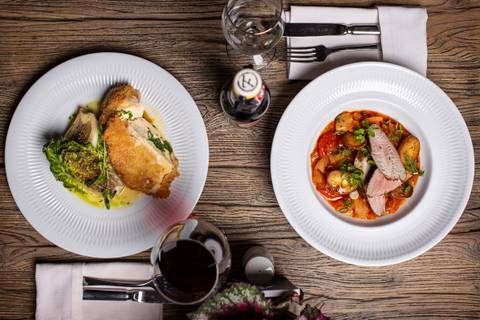Since ancient times, Hungary is continually revered for its remarkable variety of fertile soils and climates that are perfect for cultivating great grapes, and thus great wines. The country has 22 designated wine regions that each bear special circumstances for producing impressive reds, whites, and rosés, and almost all of them are available in Budapest. Here we offer a brief overview of each terrific terroir and the types of berries that flourish in them, along with some of the significant wineries operating there.
1/22
Ászár-Neszmély
At the northern edge of Hungary where the Gerecse Hills cascade toward the Danube, the consistently cool and humid conditions here are superb for growing Chardonnay and Pinot Gris for delicately flavorful white wines with rich aromas. Sauvignon Blanc, Pinot Gris, and Olaszrizling (Italian Reisling) are especially popular products of this region; Hilltop is the leading winemaker of this area, while the venerable Szöllősi Estate dates back to 1830.
2/22
Badacsony
On the slopes of a dramatic volcanic butte towering above Lake Balaton’s north shore, this esteemed region is equally appreciated for its beauty and terroir. Sheltered from northern winds, the sub-Mediterranean climate here fosters Olaszrizling and Pinot Gris grapes that are distilled into full-bodied whites with high acidity. Many small family-owned vineyards cover this steep hill, while the Németh, Szeremley, and 2HA wineries stand out nationwide.
3/22
Balatonboglár
The sparkling waters of Lake Balaton reflect across the broad plains on its southern shore, making it appropriate that this terroir is particularly renowned for its full-bodied sparkling wines. Olaszrizling and Chardonnay are the dominant grapes and varieties created here, but some red grapes like Cabernet Franc and Merlot are also growing in popularity. In 2010, the area’s Légli winery won top honors nationwide, while Garamvári is another favorite.
4/22
Balaton-felvidék
With its name meaning “Balaton Highlands”, this widespread region is tucked amid the volcanic hills north of Hungary’s biggest lake, receiving plenty of sunshine to nourish vines of Pinot Gris, Olaszrizling, and some Chardonnay that provide graceful white wines with agreeable aromas and acidity. The diverse geographical features of this area create wines of variegated character; Liszkay and Pántlika are two widely respected large-scale producers.
5/22
Balatonfüred-Csopak
This region’s broad sun-splashed expanse of rolling hills north of Lake Balaton enjoys mild winters and warm summers, creating fine conditions for growing white-wine grapes like Olaszrizling, Tramini, and Chardonnay – although the picturesque Tihany peninsula also produces red berries like Kékfrankos, Zweigelt, and Merlot. Significant vintners of the area include the Figula Winery, the Jásdi Wine Cellar, and the organically farmed Dobosi Winery.
6/22
Bükkalja
Nestled within northeastern Hungary’s forested Bükk Mountains, this awe-inspiring terroir is located on the south-facing slopes and is mostly renowned for producing white-wine berries like Olaszrizling, Leányka, and Pinot Gris, although it is also known for nice red grapes like Cabernet Franc and Pinot Noir. As one of the least developed Hungarian wine regions, most vintners here are small-scale operators, but the Mezei Winery is growing fruitfully.
7/22
Csongrád
Amid the wide-open plains near Szeged, this is the sunniest wine region nationwide, with the resulting dry conditions tempered by inconsistent rain and snow. Winemaking activity dates back centuries here, but the region’s output primarily consists of table wines produced from red Kékfrankos and Kadarka grapes – however, some whites are made from Olaszrizling and a native variety called Kövidinka; the specialty wines of Árpád Balog are worth trying.
8/22
Eger
Hungary’s most internationally famous red wine, tannin-rich Egri Bikavér (meaning “Bull’s Blood of Eger”) based on Kékfrankos grapes, originates here – yet this hilly region’s clay-infused soils are excellent for producing other types of fine wines like fellow reds Pinot Noir and Syrah, along with a few whites such as Leányka and Olaszrizling. Some of the country’s very best wineries are based here, including St. Andrea, Demeter, Gál, and Monarchia.
9/22
Etyek-Buda
As the closest wine region to Budapest, this sunny agricultural area has a cool climate that favors white-grape viticulture, providing the capital city with an abundant supply of Chardonnay, Savignon Blanc, Riesling, Olaszrizling, and Pinot Gris. The soils here impart a vivid acidity to the berries, which is ideal for the sparkling wines of Budapest’s historic Törley company, while Nyakas produces an exquisite assortment of vintages and cuvées.
10/22
Hajós-Baja
Sunshine in plentiful in this southwestern corner of Hungary’s loess-covered Great Plains, making this an opportune location for white-grape vines of Chardonnay, Hárslevelű, and Kövidinka, while Hajósi Olaszrizling is a traditional regional specialty. Some red berries like Kékfrankos and Cabernet Sauvignon are also grown here and used for reds and rosés by the popular Koch Winery and the notable Sümegi Cellars, along with some flavorful ice wines.
11/22
Kunság
Sprawling across an immense area of the Great Plains from Hungary’s southern border to the vicinity of Budapest, this is the country’s biggest wine region by far, and for a long time the area was dedicated to producing mass quantities of red and white table-wine grapes. However, in recent years vintners are making impressive progress here – Frittmann earns awards for its rosés and Irsai Olivér, while the Font Winery uses 21st-century technology.
12/22
Mátra
Like a blanket of vineyards covering the foothills of Hungary’s northern mountains, this expansive wine region is a huge swath of undulating volcanic terrain, where wine is continually made for well over a millennium now. The temperate climate and sheltered hillsides provide a good habitat for white-wine grapes like Olaszrizling, Tramini, and high-quality Muscat Ottonel – significant vintners here include Mátyas & Zoltán Szőke and József Ludányi.
13/22
Mór
This small area between Budapest and Lake Balaton is only renowned for one type of grape and wine, but considering that its name is Ezerjó – meaning “a thousand good” – this specialization is not a bad thing. Ezerjó is an indigenous white berry that only develops properly in the Mór Valley, producing full-bodied and strongly acidic wines; the Csetvei Winery makes great Ezerjó and Chardonnay, while Csabi Miklós produces Ezerjó with modern panache.
14/22
Pannonhalma
This compact wine region envelops Hungary’s most venerated terroir; vineyards are continually cultivated here since this land was a province of ancient Rome, and since A.D. 996 viniculture is primarily managed by the Pannonhalma Abbey Winery. This is a righteous setting for growing white grapes in the loess-rich soil as plentiful sunshine radiates from the heavens, with Tramini, Sauvignon Blanc, and Olaszrizling among the most popular offerings.
15/22
Pécs
With its warm and fruitful nature, the hilly terrain surrounding this southern-Hungary city enjoys a sunny Mediterranean climate that fostered the viticulture practices introduced here by Ancient Roman colonists. The area is esteemed for spicy whites with rich aromas like Olaszrizling and Chardonnay; Cirfandli is a local treasure, and the sparkling wine is also good. The Ebner and Pécsi Püspöki wineries are two modern enterprises worth checking out.
16/22
Somló
Sheltered amid the mineral-rich soils of a dormant volcano’s crater in western Hungary’s Tapolca Basin, this tiny terroir is ideal for growing white berries such as Hárslevelű, Furmint, Tramini, and Chardonnay; it takes time for vintages from this region to mature properly, but after some years the full-bodied wines open up gracefully in the glass. Both the historic Somlói Abbey Cellar and the modern Kreinbacher estate produce distinctive tipples.
17/22
Sopron
Red-wine grapes grow robustly in the land around this venerable city at the western edge of Hungary and the Carpathian Basin, and this region is considered as the capital of Kékfrankos, although Portugieser, Cabernet Franc, Merlot, and Zweigelt also flourish here in the sub-Alpine climate. Among several vintners specializing in Kékfrankos, Weninger produces some particularly velvety vintages, and the small-scale Luka Winery also makes nice Zewigelt.
18/22
Szekszárd
Grapevine cultivation has long traditions in this ruggedly hilly section of southern Hungary, where spicy red wines are produced with full-bodied flavor. Kadarka is the most renowned berry here, integral for the creation of the region’s own Bikavér – often smoother than the more famous Eger variety – while other impressive area vintages include Cabernet Sauvignon, Kékfrankos, and Merlot. The Takler family produces great wines here since the 1700s.
19/22
Tokaj
Blessed with a unique combination of volcanic soils, the confluence of the Tisza and Bodrog rivers, and hills rising from the Great Plains, the microclimate here begets one of the world’s top sweet wines, Tokaji Aszú. Nonetheless, the Furmint grapes grown here are also used to make extraordinary dry whites, with Hárslevelű also growing in popularity. Among many significant wineries here, Szepsy, Szent Tamás, Gróf Degenfeld, Oremus, and Disznókő are some of the very best.
20/22
Tolna
Although viniculture has been practiced here for thousands of years, this is one of the country’s newest designated wine regions, and thus remains somewhat underdeveloped for now – but this huge expanse of central Hungarian land shows a lot of potential for the future. Varied grapes (including red Kadarka and Kékfrankos, and white Olaszrizling and Chardonnay) are grown here for winemakers of commendable quality, such as the Fabro Winery in Paks.
21/22
Villány
Basking in the bright sunshine of southern Hungary, this region of gently rolling hills boasts a sub-Mediterranean climate that nurtures high-caliber red-wine grapes – Portugieser, Cabernet Franc, Merlot, and Cabernet Sauvignon all thrive in this fertile area, attracting eminently talented winemakers to produce exquisite vintages. Many of the nation’s most prized estates are located here, such as Bock, Gere, Sauska, Tiffán’s, Vylyan, and Wunderluch.
22/22
Zala
The clay-rich rolling hills of this large wine-growing area – one of the biggest in Hungary, spreading from the west end of Lake Balaton to the country’s southwest border - provide ample terrain for producing acidic white grapes like Olaszrizling and the locally popular Zala Gyöngye. Not too many prominent vintners operate here, but the Bussay Winery produces fine Pinot Gris and Tramini, while Kerkaborum makes delicious Furmint with pleasing aromas.


























